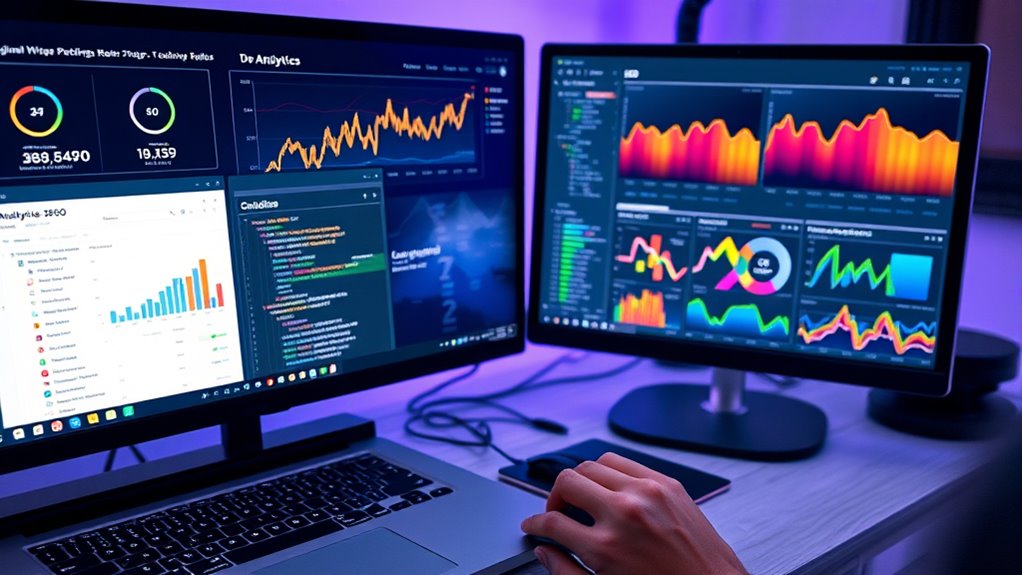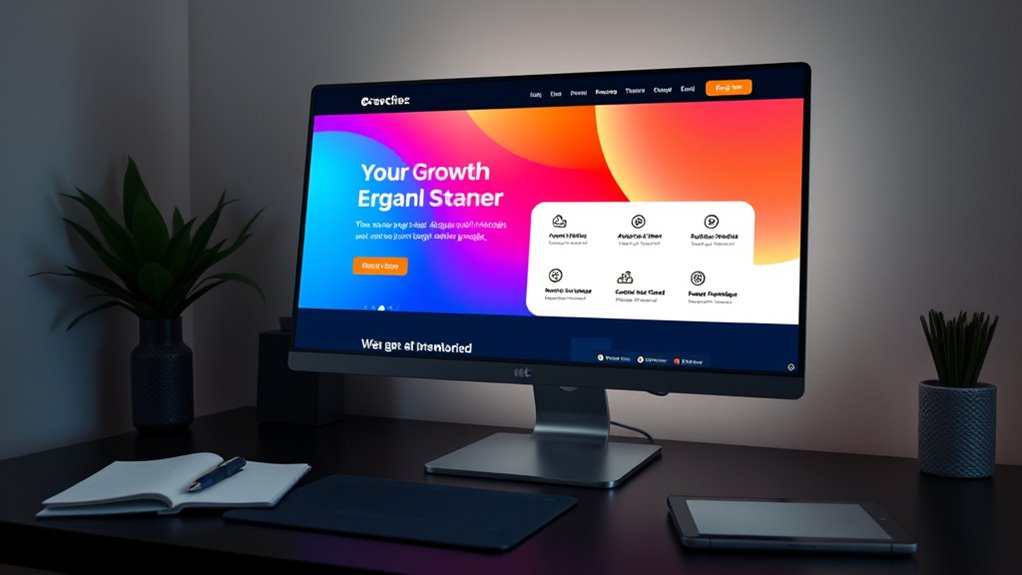To achieve sustainable organic growth, merge your SEO and CRO strategies into a holistic approach. Focus on optimizing your site’s technical performance, creating relevant content, and enhancing user experience with fast load times and clear visual cues. Track key metrics like bounce rates and conversions to make data-driven improvements. By aligning search visibility with user engagement tactics, you’ll build a stronger online presence. If you continue exploring, you’ll discover how to master this powerful convergence for long-term success.
Key Takeaways
- Integrating SEO and CRO strategies creates a seamless user experience that boosts both search rankings and conversions.
- Data-driven insights optimize content, technical elements, and user behavior for holistic organic growth.
- Enhancing site speed, mobile responsiveness, and UX aligns SEO and CRO goals effectively.
- Visual cues and personalized content guide visitors toward desired actions, increasing engagement and conversions.
- Combining brand storytelling, influencer outreach, and keyword strategies builds trust, relevance, and ongoing user interest.
Understanding the Overlap Between SEO and CRO

Although SEO and CRO have different primary goals—driving traffic versus increasing conversions—they actually share many strategies and techniques. For example, optimizing your website’s backlink profiles not only boosts your search rankings but also enhances user trust, which increases conversion chances. Addressing keyword cannibalization is another common task; it ensures your content isn’t competing against itself in search results, helping both SEO and CRO efforts. When your keywords are clear and targeted, you attract the right visitors, who are more likely to convert. Both disciplines also rely on analyzing user behavior and making data-driven adjustments to improve site performance. Incorporating user experience considerations, such as page load speed and mobile responsiveness, further aligns SEO and CRO goals. Additionally, leveraging AI-driven content clusters can help create more relevant and interconnected content, strengthening both SEO rankings and user engagement. Understanding the importance of content quality can also positively impact how visitors interact with your site, thereby supporting both strategies. Recognizing these overlaps helps you develop a cohesive strategy, maximizing your organic reach while improving user engagement and conversions. Furthermore, understanding the importance of emotional support can foster trust and loyalty among visitors, indirectly boosting conversion rates. Incorporating a comprehensive content strategy ensures consistent messaging and authority building across channels, benefiting both SEO and CRO initiatives.
The Benefits of Integrating SEO and CRO Strategies

Integrating SEO and CRO strategies offers a powerful way to maximize your website’s effectiveness. When you combine these approaches, you create a seamless experience that attracts visitors and converts them into customers. Using brand storytelling within your SEO efforts helps build emotional connections, making your site more engaging and memorable. Benefits of Curiosity can be extended to your content strategy by exploring new topics and engaging users with fresh perspectives, fostering ongoing interest. CRO techniques guarantee those visitors take action, whether signing up or making a purchase. Additionally, influencer outreach can amplify your message, boosting visibility and credibility. This synergy enables you to optimize content for search engines while enhancing user experience, leading to higher organic traffic and conversion rates. Incorporating mobile responsiveness into your site layout can further improve engagement and reduce bounce rates. For example, showcasing local favorites like Dri Dri Gelato can create a more personalized experience for visitors. Recognizing the importance of educational and skill-building toys in child development can inform content that appeals to parents seeking quality products. Ultimately, integrating SEO and CRO helps you achieve sustainable growth by aligning your marketing efforts around a unified, conversion-focused strategy.
Key Metrics to Track for Holistic Digital Growth

To truly gauge the success of your integrated SEO and CRO efforts, you need to focus on the right metrics. Analytics benchmarks help you measure performance against industry standards, revealing how your site stacks up in key areas. Keep an eye on organic traffic, bounce rates, and conversion rates to assess user engagement and the effectiveness of your strategies. Setting clear objectives is essential for meaningful measurement and progress tracking. Brand awareness metrics, like branded search volume and social mentions, indicate how well your brand resonates with your audience. Tracking these metrics provides a holistic view of your digital growth, highlighting areas for improvement and validating your combined efforts. Regularly analyzing these key indicators guarantees you’re aligned with your goals and adapting to evolving market dynamics. Incorporating personal growth principles, such as continuous self-improvement and mindful analysis, can further enhance your digital strategy. Additionally, understanding user behavior patterns can help refine your approach and foster long-term engagement. Monitoring toilet maintenance and repair metrics can offer insights into user experience and operational efficiency, especially for businesses in the hospitality and facility management sectors. Recognizing the importance of special events and themed breakfasts in community engagement can also inspire innovative marketing strategies and content ideas.
Aligning Content Strategies for Better Engagement

Aligning your content strategies is crucial for driving better engagement, as it guarantees that your messaging resonates consistently across all channels. When you focus on content alignment, you ensure that your content speaks directly to your audience’s needs and interests. Audience segmentation plays a fundamental role here; by dividing your audience into specific groups, you can tailor your content to address their unique preferences and pain points. This targeted approach boosts relevance, encourages interaction, and builds trust. Consistent messaging across channels reinforces your brand voice and helps establish authority. Remember, aligned content that speaks directly to segmented audiences increases engagement, improves SEO rankings, and supports your CRO efforts. Additionally, understanding your audience’s preferences—such as those seen with vetted products like the Flat Iron Bike—can help refine your content strategy for even better results. Incorporating insights from electric dirt bike pricing and performance can further enhance your content relevance and appeal. Ensuring your content remains consistent across platforms is essential for creating a seamless experience that keeps your audience coming back. Moreover, leveraging personalized content techniques can significantly elevate engagement levels by making your messaging more relevant and compelling. Using water-based therapies as an example of engaging content can help diversify your strategy and address different audience interests. Ultimately, a unified content strategy creates a seamless experience that keeps your audience coming back.
Enhancing User Experience to Boost Conversions

Enhancing user experience is essential for increasing conversions because it directly influences how visitors interact with your website. When you deliver personalized content tailored to their needs, they’re more likely to stay and convert. Incorporate user feedback to identify pain points and improve navigation, making the journey smoother. Focus on fast load times, clear calls-to-action, and intuitive design to keep visitors engaged. By prioritizing these elements, you create a seamless experience that encourages conversions. Additionally, understanding the importance of contrast ratio can help optimize visual clarity, especially in multimedia-rich environments. Considering support hours and operational schedules, such as those for entertainment parks like SeaWorld or Disneyland, can also enhance user satisfaction by aligning expectations with available services. Recognizing the role of AI in healthcare further underscores how technological advancements can personalize user experiences and streamline interactions. Consider this table to understand how different factors contribute:
| Personalization | User Feedback | Website Performance |
|---|---|---|
| Relevant content | Identifies issues | Fast loading speeds |
| Targeted offers | Guides improvements | Mobile responsiveness |
| Custom experiences | Builds trust | Easy navigation |
These strategies foster trust, engagement, and ultimately, higher conversions. Enhancing these aspects can also positively impact your site’s search engine rankings, making your content more accessible to a broader audience. Moreover, ensuring website accessibility can broaden your reach and improve user satisfaction across diverse user groups.
Leveraging Data and Analytics for Informed Decisions

Harnessing data and analytics enables you to make smarter, more informed decisions that drive your SEO and CRO efforts. Start by conducting thorough keyword research to identify high-value terms your audience searches for, ensuring your content aligns with their intent. Use competitor analysis to uncover gaps and opportunities, learning what strategies they employ and where you can outperform them. Analyzing website metrics, such as bounce rates, click-through rates, and conversion paths, helps you understand user behavior and identify areas for improvement. By continuously monitoring these data points, you can refine your content, optimize landing pages, and adjust your strategies to maximize organic growth. Incorporating user experience considerations ensures that your website remains engaging and accessible, further enhancing conversion rates. Regularly applying data-driven decision making principles allows for ongoing improvements based on real-world performance metrics. Leveraging data and analytics transforms guesswork into targeted, effective actions that boost both search rankings and conversions.
Technical Optimization for Search and User Satisfaction

To improve both search rankings and user experience, focus on optimizing your site speed, ensuring your design is mobile-friendly, and implementing structured data. Fast-loading pages keep visitors engaged and boost conversions, while a responsive design caters to users on any device. Structured data helps search engines understand your content better, making your site more visible in relevant searches.
Site Speed Optimization
Site speed is a critical factor that directly impacts both your search engine rankings and user experience. When your page load times are slow, visitors become impatient, increasing bounce rates and decreasing conversions. To optimize, focus on reducing server response times so your site can deliver content swiftly. Minimize unnecessary scripts and compress images to improve load speed. Use caching effectively to serve repeated visitors faster. Regularly test your site’s performance with tools like Google PageSpeed Insights or GTmetrix, and address any bottlenecks promptly. Remember, fast-loading pages not only boost your SEO but also create a smoother, more satisfying experience for users, encouraging them to stay longer and engage more. Prioritizing site speed is essential for holistic growth.
Mobile Responsiveness Design
Have you guaranteed your website offers a seamless experience on all devices? Mobile usability is essential for both search rankings and user satisfaction. Responsive layouts ensure your site adapts smoothly to different screen sizes, providing visitors with easy navigation and readable content. A mobile-friendly design reduces bounce rates and increases engagement, positively impacting your SEO. Test your site on various devices to identify usability issues and optimize touch elements for accessibility. Fast-loading, responsive pages improve user experience and signal to search engines that your site is trustworthy and relevant. Investing in mobile responsiveness not only boosts your rankings but also enhances conversion rates, making it a key component in your holistic growth strategy. Prioritize mobile usability to meet modern user expectations effectively.
Structured Data Implementation
Wondering how search engines understand your website? Structured data implementation, like schema markup, helps clarify your content’s context. By adding schema markup, you enable search engines to interpret your site’s information more accurately, improving your chances of appearing in rich snippets and voice search results. This technical optimization not only boosts visibility but also enhances user satisfaction by delivering more relevant, detailed results directly in search responses. Incorporate schema markup for products, reviews, FAQs, and other content types to make your site more understandable. As voice search becomes more prevalent, structured data ensures your content is easily accessible through voice assistants, giving you a competitive edge. Ultimately, implementing schema markup aligns your SEO and CRO efforts, fostering better engagement and organic growth.
Designing Landing Pages That Rank and Convert

To create landing pages that both rank well and drive conversions, you need to master visual hierarchy strategies that guide visitors effortlessly. A clear call-to-action design guarantees users know exactly what to do next, increasing engagement. When you combine these elements effectively, your landing pages will perform better in search results and generate more leads.
Visual Hierarchy Strategies
Effective visual hierarchy is essential for creating landing pages that both rank well in search engines and drive conversions. You achieve this through strategic use of color contrast and font hierarchy, guiding visitors’ attention naturally. Bright, contrasting colors highlight key elements, while consistent font sizes and styles establish a clear content structure. Use the table below to understand how different elements work together:
| Element | Purpose |
|---|---|
| Headlines | Grab attention, set content importance |
| Subheadings | Organize sections, improve scannability |
| Callouts/Highlights | Emphasize critical info with color contrast |
| Body Text | Maintain readability with appropriate font size |
| Buttons & Links | Stand out using contrasting colors for clickability |
Clear Call-to-Action Design
A well-designed visual hierarchy naturally guides visitors’ attention, but clear call-to-actions (CTAs) are what ultimately motivate them to take the next step. To optimize your landing pages, focus on making your call to action stand out with strong visual cues like contrasting colors, bold typography, and strategic placement. Use concise, compelling copy that clearly states the benefit or next step, removing any ambiguity. Ensure your CTA is easy to find without scrolling or searching, aligning it with the most relevant content. Effective visual cues direct visitors toward the CTA, reducing confusion and increasing conversions. Remember, a well-crafted call to action not only guides visitors but also inspires action, bridging the gap between organic traffic and meaningful engagement.
Implementing A/B Testing to Refine Your Approach

Implementing A/B testing is essential for fine-tuning your SEO and CRO strategies, as it allows you to compare different versions of your pages and see which performs better. Use A/B testing to evaluate personalization tactics, such as customized headlines or targeted offers, to see what resonates with your audience. Incorporate user feedback into your tests by analyzing how visitors respond to different layouts, calls-to-action, or content variations. This data helps you identify the most effective elements that boost engagement and conversions. Remember, consistent testing and refinement create a feedback loop that enhances both your organic rankings and user experience. By systematically refining your approach, you ensure your site remains optimized for both search engines and visitors.
Building a Sustainable, Long-Term Growth Model

To build a sustainable, long-term growth model, you need to focus on creating strategies that adapt to evolving market conditions and audience behaviors. Incorporate brand storytelling to connect emotionally with your audience, fostering loyalty and trust. Develop detailed customer personas to understand their needs, preferences, and pain points, ensuring your content and offers resonate. Continuously refine your messaging based on feedback and data, aligning your SEO and CRO efforts with your audience’s shifting expectations. Prioritize consistency in delivering value and maintaining authenticity through your storytelling, which helps differentiate your brand over time. By integrating these elements, you establish a resilient foundation that sustains organic growth and adapts seamlessly to future changes.
Frequently Asked Questions
How Do SEO and CRO Influence Each Other’S Success?
You see, SEO and CRO influence each other’s success through Keyword Alignment and Conversion Optimization. When you optimize your content for the right keywords, it attracts more targeted traffic, which boosts your chances of conversions. Conversely, analyzing conversion data helps you refine your SEO strategies by understanding what users want. This synergy creates a cycle where better keyword targeting and conversion-focused tweaks improve both your rankings and your conversion rates.
What Are Common Pitfalls When Integrating SEO and CRO?
Did you know that 70% of website owners face issues with conflicting priorities? When integrating SEO and CRO, common pitfalls include overlooking keyword cannibalization, which can dilute your rankings, and misalignments between SEO and CRO strategies. These conflicts hinder organic growth and user experience. To succeed, you must balance both disciplines, ensuring that your keywords support both search rankings and conversion goals without competing against each other.
How Can Small Businesses Effectively Combine SEO and CRO?
To effectively combine SEO and CRO, focus on content personalization to meet your audience’s needs and preferences. Guarantee brand consistency across your website to build trust and recognition. Use data from your SEO efforts to identify high-performing content, then optimize those pages for conversions. Regularly test and refine your strategies, keeping both SEO and CRO aligned to attract more visitors and turn them into loyal customers.
What Tools Best Support a Holistic SEO and CRO Strategy?
To support a holistic SEO and CRO strategy, you should use tools that focus on keyword research and A/B testing. Google Analytics and SEMrush help identify the best keywords to target, while tools like Optimizely and VWO enable you to run A/B tests to optimize user experience. Combining these tools provides insights that improve your search rankings and conversion rates, making your efforts more effective and aligned.
How Does User Intent Shape Both SEO and CRO Efforts?
User intent shapes both SEO and CRO efforts by guiding your personalization strategies and ensuring content alignment. When you understand what users want, you can tailor your website and content to meet their needs more effectively. This focus helps improve search rankings and conversions, as you’re providing relevant experiences. By aligning your strategies with user intent, you create a seamless journey that increases engagement and drives organic growth.
Conclusion
By weaving SEO and CRO together, you create a powerful engine driving your digital growth. Think of it as a symphony where every note—your content, design, and technical tweaks—works in harmony. When you align these strategies, you don’t just chase rankings or conversions—you build a resilient foundation that keeps your organic growth thriving like a well-tended garden. Embrace this holistic approach, and watch your online presence bloom beyond expectations.










